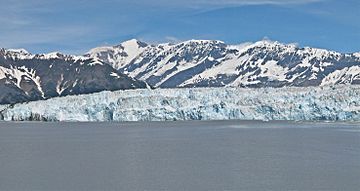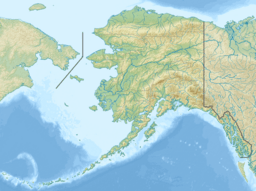Mount Foresta facts for kids
Quick facts for kids Mount Foresta |
|
|---|---|

Mount Foresta seen from Disenchantment Bay with Hubbard Glacier
|
|
| Highest point | |
| Elevation | 11,000+ ft (3,350+ m) |
| Prominence | 5,300 ft (1,600 m) |
| Listing | |
| Geography | |
| Location | Wrangell–St. Elias National Park Alaska, United States |
| Parent range | Saint Elias Mountains |
| Topo map | USGS Mount Saint Elias A-4 |
| Climbing | |
| First ascent | 1979 Fred Beckey |
Mount Foresta is a very tall mountain in Alaska, United States. It's part of the Saint Elias Mountains and is located inside Wrangell–St. Elias National Park. This huge mountain stands about 11,000 feet (3,353 meters) high! It's actually a group of peaks that form one large mountain.
Mount Foresta rises high above the lower part of the Hubbard Glacier. The top of the mountain is only about 9 miles (14.5 kilometers) from the ocean at Disenchantment Bay. It is also near other big mountains like Mount Seattle and Mount Vancouver.
About Mount Foresta's Name
The mountain was named after a special person named Foresta Hodgson Wood. She lived from 1904 to 1951. Foresta was very important for a big science trip called Project Snow Cornice. This project was organized by the Arctic Institute of North America.
Sadly, Foresta and her daughter, Valerie F. Wood, passed away in an airplane accident near this mountain on July 27, 1951. This happened during the science trip. Because of this, a glacier on the southwest side of Mount Foresta is named the Valerie Glacier. The names for the mountain and the glacier were suggested in 1957.
First Climbers
The first time anyone successfully climbed to the top of Mount Foresta was on July 24, 1979. The climbing team included Fred Beckey, Rick Nolting, John Rupley, and Craig Tillery.
Weather and Climate
Mount Foresta is in a subarctic climate zone. This means it has long, cold, and snowy winters. The summers are usually cool.
The weather systems that come from the Gulf of Alaska hit the tall Saint Elias Mountains. This forces the air upwards, which causes a lot of rain and snow to fall. This process is called orographic lift.
Temperatures on the mountain can drop very low, sometimes below -20 °C (-4 °F). With the wind, it can feel even colder, below -30 °C (-22 °F). If you want to visit or climb, the best weather is usually in May and June.


